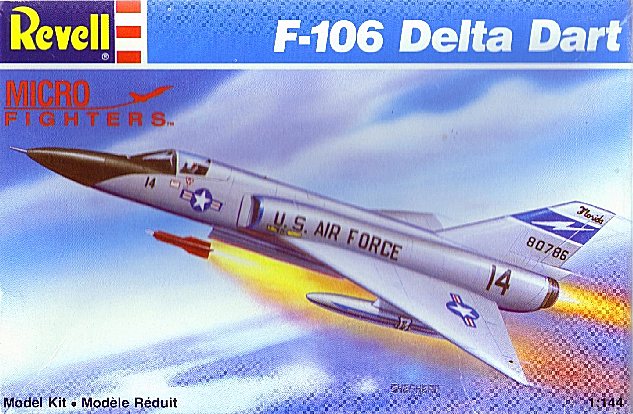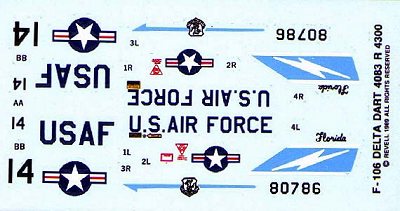
|
KIT: |
Revell 1/144 F-106A Delta Dart |
|
KIT # |
4083 |
|
PRICE: |
@$5.00 |
|
DECALS: |
One aircraft |
|
REVIEW & |
Mark Williams |
|
NOTES: |
Out of Production (Feb 2001) |

|
HISTORY |
Regarded by many as being the finest, all-weather interceptor ever built, the Convair F-106A Delta Dart served on active duty with the US Air Force for 28 years (1959-1987) - much longer than most of its contemporaries - and from 1972 to 1988 with the Air National Guard. Developed from the Convair F-102 Delta Dagger and designed from the ground up as an interceptor, it was originally designated the F-102B but was redesignated the F-106 because of its extensive structural changes and the more powerful Pratt & Whitney J-75 engine. The first F-106A flew on December 26, 1956. Deliveries to the Air Defense Command were made beginning in May, 1959, and production ended in late 1960. A total of 277 F-106As and 63 F-106Bs were built. Continuously upgraded during its service life, the "Six" proved to be quite a buy for the Air Force. Beginning in 1986, 194 F-106s were converted to QF-106s and used as target drones at Holloman and Tyndall Air Force Bases until 1997 and 1998 respectively until replaced by QF-4s. 15 F-106s and 6 QF-106s survive at AMARC and 17 airframes are on display in museums around the United States.
On December 15, 1959, Colonel (then Major) Joseph W. Rogers broke the world, absolute, speed record in an F-106A (s/n 59-0467) with a flight measured at 1525.95 mph. This record still stands for a single-engine, production turbojet!
|
THE KIT |
This is one of the Micro Fighters series made my Revell. Copyright on the kit is 1989 but I'm not sure of the exact dates this series was produced. My first impression was that this is a miniature version of Hasegawa's, 1:72 F-106A in 1:144! The main difference being this kit has engraved panel lines whereas the Hasegawa kits have raised panel lines. Instructions are diagram-only and quite simple - perhaps too simple. Note that Step 1 shows the cockpit tub facing backwards. There are 53 parts on three sprues including a one-piece, clear canopy. Inspecting it closely, it appears to have been molded with the original, old-style frame but the markings are so light it can easily be painted as a "bubble" canopy, which is correct for the markings. Conspicuously missing from these 53 parts however are outer, main-gear doors! Make some from sheet styrene using the gear door spaces in the wings as a guide.
Included is a multi-part, weapons bay with two, AIM-4 Falcon missiles but these immediately caught my eye as being too big. I scaled these out at 1:103 and being so grossly large, they should be left off the model. That being the case, the weapon bay can be built closed (there isn't any real kit detail there anyway), but may require some filling and sanding work since the doors come in four pieces. It may be difficult to scribe the M-61 purge vents into the lower, forward weapons bay though! With respect to detail, the weapons bay, as well as the landing gear bays are again, miniature versions of Hasegawa's, 1:72 F-106A.
That said about the AIM-4s, one option I am considering is sanding the wings down to create a couple Weapon System Evaluator Missiles, or WSEMs. These were slung in the weapons bay and actually lowered into the airstream, but never fired, simulating a real missile launch and collecting data on the launch parameters. (Read and see more on these missiles in References C, F and J.) The WSEMs were based on actual AIM-4 bodies so the length works out to approximately 86" full-size, and roughly 19/32" in 1:144 scale. Looking at the example model on the kit box I suspect the launch rails will need to be chopped slightly to fit higher in the bay for this option. The box photograph of a completed model shows the launch rails too low but this may be just from poor construction. Be prepared for some tweezer work in the weapons bay if you choose to build it open.
Examining the wing tanks I noticed they appeared to be too small. Measuring out to 1:169 confirmed my "eyeballing" but I can live with that and will use them. (These and the Falcons are the only obvious, off-scale pieces.) The wings are molded in one-piece and I predict some filling and sanding when attaching these. The same work is required when adding the air intakes to the fuselage. Additionally, the wings do not have the slots molded in the leading edges so you will need to cut them in yourself. Again, refer to the references for correct placement. The radome does not have a hole for the pitot tube but it shouldn't be a problem to sand the tip down slightly to ease placement of the tube. Also, it does not fit smoothly to the fuselage so some putty will be needed to match it up. The cockpit lacks detail (and a pilot!) but has an ejection seat and Hasegawa-like instrument panel. The top of the nose-gear bay doubles as the cockpit tub.
For the really, hard-core, F-106 fans you can try to add the fuselage antennas including the UHF, TACAN, data link, strip marker beacons, yaw and AOA vanes, and the artificial feel system pitot tubes on the vertical tail using sheet styrene or pieces of sprue! That is, if you haven't tired of all the fixes this kit will need! Get the magnifying glasses out for those and refer to the references for correct placement! (Remember that the yaw vane was only added to the "vertical-tape" instrumented A-models that got the gun.)
 As I know
of no after-market decals for the F-106 in 1:144, you're committed to the
enclosed, 159th Fighter Interceptor Squadron (125th Fighter Interceptor Group,
Florida Air National Guard.) You'll notice the blue on the tail flash and wing
tank decals is too light when compared to the actual markings and there are no
stencils other than the primary markings. They are a little thick and my set
will need to be trimmed up a bit prior to placement. Other than the color and
lack of detail in the ANG shield, the markings provided are pretty accurate
including the aircraft number (14) assigned by the 159th. (For a detailed
history of 58-0786, see Reference F, page 79.) Use ADC Gray paint (FS 16473) for
the exterior and please don't paint the forward frame of the canopy black as
shown on the box art and example! The only time I've seen the forward canopy
rails painted black was on the Eclipse Project aircraft. (See Reference F.) If
you try the WSEM modification I mentioned above, paint the missile body blue -
like the current training missiles used - with white radomes.
As I know
of no after-market decals for the F-106 in 1:144, you're committed to the
enclosed, 159th Fighter Interceptor Squadron (125th Fighter Interceptor Group,
Florida Air National Guard.) You'll notice the blue on the tail flash and wing
tank decals is too light when compared to the actual markings and there are no
stencils other than the primary markings. They are a little thick and my set
will need to be trimmed up a bit prior to placement. Other than the color and
lack of detail in the ANG shield, the markings provided are pretty accurate
including the aircraft number (14) assigned by the 159th. (For a detailed
history of 58-0786, see Reference F, page 79.) Use ADC Gray paint (FS 16473) for
the exterior and please don't paint the forward frame of the canopy black as
shown on the box art and example! The only time I've seen the forward canopy
rails painted black was on the Eclipse Project aircraft. (See Reference F.) If
you try the WSEM modification I mentioned above, paint the missile body blue -
like the current training missiles used - with white radomes.
|
CONCLUSIONS |
Having recently returned to modeling (after deciding it was cheaper than the typical, mid-life-crisis Corvette!) and always being a big F-106 fan, I'm very excited that I found this kit and equally excited about getting started on it. Given the relatively minor quirks I've mentioned, I think a really neat model can be built with this kit if you can find one. Recently I've noticed this kit through on-line auctions and seen it go for as high as $22.00! Look around, shop carefully as usual, and you should be able to find it for around $5.00. Now to get a 1:144, Tu-95 for my little Six to intercept!
|
REFERENCES |
1.. Carson, Don, and Lou Drendal, F-106 Delta Dart in Action (Aircraft No. 15), Squadron/Signal Publications, Carrollton, TX, 1974
2.. Holder, William G., Convair F-106 Delta Dart, (Aero Series 27), Aero Publishers, Fallbrook, CA, 1977
3.. Kinzey, Bert, F-106 Delta Dart in Detail and Scale, (D&S Volume 13), Aero Publishers, Fallbrook, CA, 1983
4.. Kinzey, Bert, Colors and Markings of the F-106 Delta Dart, (C&M Volume 1), Aero Publishers, Fallbrook, CA, 1984
5.. Foster, Peter R., USAF Fighter Interceptor Squadrons, Osprey Aerospace, London, 1994
6.. Dorr, Robert F., with Terry Panopalis, "Convair F-106 Delta Dart - The Ultimate Interceptor," Wings of Fame, Volume 12, 1998, pp. 36-97
7.. Mancus, Peter, "Red Alert - The F-106 and the Case for Manned Interceptors," Wings, Volume 11, No. 3, June, 1981, pp. 24-35
8.. Deal, Duane W., "F-106 - Biggest Deal of the Century Series," Wings, Volume 14, No. 3, June, 1984, pp. 20-29, 48-55
9.. Larcom, Craig, ""Goodbye To All That!"," Wings, Volume 17, No. 5, October, 1987, pp. 24-35
10.. McGee, Patrick J. (Webmaster), Pat's World, F-106 Delta Dart, www.f-106deltadart.com, 1998-2001
k.. Smalley, Erville G. (Webmaster), Convair F-106 Delta Dart - The Survivors, www.homestead.com/convairf106deltadart/index.html, 2000-2001
If you would like your product reviewed fairly and quickly by a site that has over 1,800 visits a day, please contact me or see other details in the Note to Contributors.